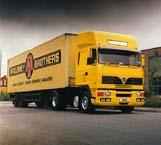|
|
|
|
|
|
|
|
|
|
|
|
|
|
Torque vs. Horsepower
The terms horsepower and torque can be confusing at times. One of the top authoritative magazines on engines, Hot Rod Magazine, took twenty pages to explain torque vs. HP. Here's a paraphrase of what they said.
Simply defined, horsepower is the rate of doing work over a given amount of time. According to experts from SAE, one horsepower (1 HP) equals 550 ft-lb. per second or 33,000 ft-lb. per minute. Another familiar formula is the one which states RPM x Torque / 5252 = horsepower
Torque is the measurement of the strength of the rotational movement and determines how fast a car, boat, or airplane accelerates up to a required speed.
An example here should be helpful:
 Think of a V-8 car engine that puts out approximately 300 HP or
more at 6,000 rpm compared to a large diesel semi-truck that puts out 300 HP at 2,200 rpm. They are both 300 HP engines; however, they are very different and offer different performance capabilities. The
V-8 car engine puts out 300 HP and produces 263 ft-lb. torque at its top working speed of 6,000 rpm. The diesel truck engine puts out 300 HP but puts out 716 ft-lb. torque at its top working speed of 2,200
rpm.
Think of a V-8 car engine that puts out approximately 300 HP or
more at 6,000 rpm compared to a large diesel semi-truck that puts out 300 HP at 2,200 rpm. They are both 300 HP engines; however, they are very different and offer different performance capabilities. The
V-8 car engine puts out 300 HP and produces 263 ft-lb. torque at its top working speed of 6,000 rpm. The diesel truck engine puts out 300 HP but puts out 716 ft-lb. torque at its top working speed of 2,200
rpm.
If you put the V-8 car engine into a diesel truck (even though it is also 300 HP) it can not even move the truck.  This is because the low speed strength (TORQUE) of the V-8 is not sufficient to even get started. The diesel engine has much higher torque but is very large in size and weight,
i.e. 700 - 900 cubic inches and 2500 lb. in weight. And obviously, you could not put a diesel engine in a car because it is too big and heavy.
This is because the low speed strength (TORQUE) of the V-8 is not sufficient to even get started. The diesel engine has much higher torque but is very large in size and weight,
i.e. 700 - 900 cubic inches and 2500 lb. in weight. And obviously, you could not put a diesel engine in a car because it is too big and heavy.
The diesel engine is also much more expensive. If you want an engine with twice the torque, they cost 200% to 400% more than standard car engines. The diesel engine is also very loud and has a high vibration level.
The ideal is to get a high torque engine that only weighs equal or less than a car engine. Then if the engine is smaller than the car engine, you have the advantage of high torque without the disadvantages of being too big and too heavy, even though they have the same basic maximum horsepower.
This is the advantage that the Dyna-Cam engine offers, i.e. high diesel-engine torque, with less weight and smaller size than a car engine. The Dyna-Cam engine makes an ideal engine for any application where high strength (torque) is needed for acceleration and yet smaller size and lighter weight is also needed. This beneficial combination is only available in the Dyna-Cam engine.
TORQUE AND PROPELLERS
For aircraft useage, higher torque means that you can turn a larger propeller with wide turbo-prop like blades which produces higher thrust at a lower RPM with less noise than smaller propellers that turn at higher RPM.
The larger propellers can give faster take-off and better climb performance as well as better cruise. Propellers are more efficient at lower rpm levels of 1600 - 2000.
EFFECT OF TORQUE ON ENGINE COST
In the engine industry it has been a common occurrence that the customer has to pay for higher torque. A 200 HP auto engine with 250 ft. lb. of torque can be purchased new for approximately $3,000. A diesel engine that puts out 700 ft. lb. of torque usually costs $12,000 to $15,000.
ON TO NEXT SECTION "APPLICATIONS"
DynaCam Home
Product Main
Specifications
Design Overview
Performance
Advantages
Assembly
R&D
Dyno Testing
Torque vs. HP
Contact
FAQs
Mailing List
Site Map


